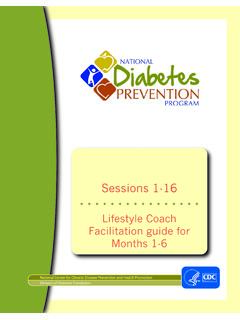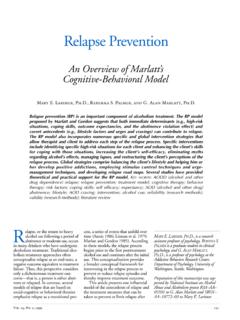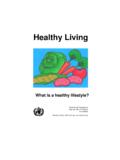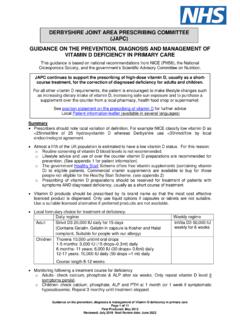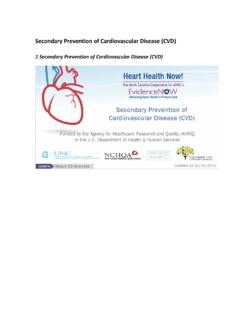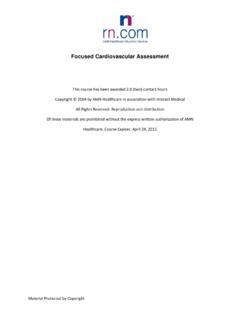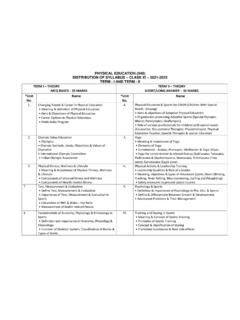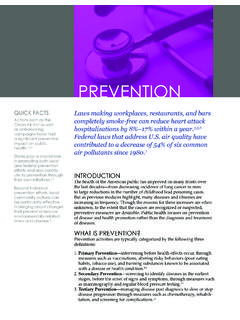Transcription of GPAQ Analysis Guide - World Health Organization
1 Global physical activity questionnaire (GPAQ) Analysis Guide Surveillance and Population-Based Prevention Prevention of Noncommunicable Diseases Department World Health Organization 20 Avenue Appia, 1211 Geneva 27, Switzerland For further information: GPAQ Analysis Guide 1 Global physical activity questionnaire (GPAQ) Analysis Guide Table of contents 1 Overview .. 2 2 The questionnaire .. 4 3 GPAQ Question by Question 6 4 Cleaning GPAQ data .. 9 5 Cleaning GPAQ data with EpiInfo .. 11 6 Analysis Guidelines and Calculations .. 14 GPAQ Analysis Guide 21 Overview Introduction The Global physical activity questionnaire was developed by WHO for physical activity surveillance in countries.
2 It collects information on physical activity participation in three settings (or domains) as well as sedentary behaviour, comprising 16 questions (P1-P16). The domains are: activity at work Travel to and from places Recreational activities Using GPAQ Prior to using GPAQ, you should review the question by question section. This section, which follows the actual questions, will Guide the interviewer in asking the questions and recording responses. When using GPAQ, all the questions must be asked. Skips of questions do ONLY apply to the corresponding day and time variables if P1, P4, P7, P10, or P13 have been answered negatively. Skipping any other questions or removing any of the domains will restrict the results that you will be able to calculate.
3 Administration of the GPAQ The GPAQ has been developed for face-to-face interviews conducted by trained interviewers. It had been tested in large scale population-based surveys with the general adult population. Show cards It is advised that show cards be used when the GPAQ is administered. Show cards should be developed for each of the activity types covered by the GPAQ: vigorous and moderate activity at work, transport activity , vigorous and moderate activity during leisure time, as well as sitting. Show cards will help the respondents to know what activities are meant by each question. They should be showing typical physical activities for the setting that the GPAQ is used in.
4 Examples of generic show cards that will need to be adapted to the local context can be found on the GPAQ website: GPAQ version 1 and 2 This document provides information on version 2 of GPAQ. It is advised that you use version 2 of GPAQ. If you have already used GPAQ version 1 and need advise on analysing this information, please contact the STEPS team at Calculating and cleaning physical activity data This document includes information on how to clean and analyse GPAQ data in general as well as specifically with the statistical package EpiInfo. The coding column of GPAQ is used as a reference for all the calculations. If you insert this questionnaire into another questionnaire , you should not change the coding column.
5 Continued on next page GPAQ Analysis Guide 31 Overview, Continued Metabolic Equivalent (MET) METs (Metabolic Equivalents) are commonly used to express the intensity of physical activities, and are also used for the Analysis of GPAQ data. MET is the ratio of a person's working metabolic rate relative to the resting metabolic rate. One MET is defined as the energy cost of sitting quietly, and is equivalent to a caloric consumption of 1 kcal/kg/hour. For the Analysis of GPAQ data, existing guidelines have been adopted: It is estimated that, compared to sitting quietly, a person's caloric consumption is four times as high when being moderately active, and eight times as high when being vigorously active.
6 Therefore, when calculating a person's overall energy expenditure using GPAQ data, 4 METs get assigned to the time spent in moderate activities, and 8 METs to the time spent in vigorous activities. GPAQ Analysis Guide 42 The questionnaire physical activity Next I am going to ask you about the time you spend doing different types of physical activity in a typical week. Please answer these questions even if you do not consider yourself to be a physically active person. Think first about the time you spend doing work. Think of work as the things that you have to do such as paid or unpaid work, study/training, household chores, harvesting food/crops, fishing or hunting for food, seeking employment.
7 [Insert other examples if needed]. In answering the following questions 'vigorous-intensity activities' are activities that require hard physical effort and cause large increases in breathing or heart rate, 'moderate-intensity activities' are activities that require moderate physical effort and cause small increases in breathing or heart rate. Question Response Code Work Does your work involve vigorous-intensity activity that causes large increases in breathing or heart rate like [carrying or lifting heavy loads, digging or construction work] for at least 10 minutes continuously? [INSERT EXAMPLES] (USE SHOWCARD) Yes 1 P1 No 2 If No, go to P 4 In a typical week, on how many days do you do vigorous-intensity activities as part of your work?
8 Number of days P2 How much time do you spend doing vigorous-intensity activities at work on a typical day? Hours : minutes : hrs mins P3 (a-b) Does your work involve moderate-intensity activity , that causes small increases in breathing or heart rate such as brisk walking [or carrying light loads] for at least 10 minutes continuously? [INSERT EXAMPLES] (USE SHOWCARD) Yes 1 P4 No 2 If No, go to P 7 In a typical week, on how many days do you do moderate-intensity activities as part of your work? Number of days P5 How much time do you spend doing moderate-intensity activities at work on a typical day?
9 Hours : minutes : hrs mins P6 (a-b) Travel to and from places The next questions exclude the physical activities at work that you have already mentioned. Now I would like to ask you about the usual way you travel to and from places. For example to work, for shopping, to market, to place of worship. [Insert other examples if needed] Do you walk or use a bicycle (pedal cycle) for at least 10 minutes continuously to get to and from places? Yes 1 P7 No 2 If No, go to P 10 In a typical week, on how many days do you walk or bicycle for at least 10 minutes continuously to get to and from places? Number of days P8 How much time do you spend walking or bicycling for travel on a typical day?
10 Hours : minutes : hrs mins P9 (a-b) Continued on next page GPAQ Analysis Guide 52 The questionnaire , Continued physical activity , Continued Question Response Code Recreational activities The next questions exclude the work and transport activities that you have already mentioned. Now I would like to ask you about sports, fitness and recreational activities (leisure), [Insert relevant terms]. Do you do any vigorous-intensity sports, fitness or recreational (leisure) activities that cause large increases in breathing or heart rate like [running or football] for at least 10 minutes continuously? [INSERT EXAMPLES] (USE SHOWCARD) Yes 1 P10 No 2 If No, go to P 13 In a typical week, on how many days do you do vigorous-intensity sports, fitness or recreational (leisure) activities?










